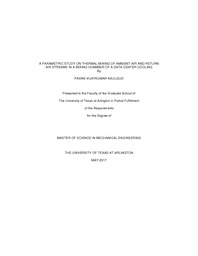
ATTENTION: The works hosted here are being migrated to a new repository that will consolidate resources, improve discoverability, and better show UTA's research impact on the global community. We will update authors as the migration progresses. Please see MavMatrix for more information.
Show simple item record
| dc.contributor.advisor | Agonafer, Dereje | |
| dc.creator | Kaulgud, Pavan Vijaykumar | |
| dc.date.accessioned | 2017-07-03T16:01:58Z | |
| dc.date.available | 2017-07-03T16:01:58Z | |
| dc.date.created | 2017-05 | |
| dc.date.issued | 2017-05-18 | |
| dc.date.submitted | May 2017 | |
| dc.identifier.uri | http://hdl.handle.net/10106/26838 | |
| dc.description.abstract | Thermal Mixing of ambient air and return air streams in a mixing chamber for data center cooling
Keywords: Data center cooling, Air side economization, Mixing chamber geometry
Pavan Kaulgud, Dr. Dereje Agonafer
Air side economization is an arrangement of duct, damper and automatic control system which together allow to introduce outside air to reduce or eliminate the mechanical cooling during mild or cold weather. In this process ambient air is drawn inside from environment, passed through filter to get rid of contaminants and then is introduced to the cold aisle of data center. According to ASHRAE, use of air side economization is mandatory when outside air conditions are favorable to reduce data center energy consumption. To maximize economizer hours, direct evaporative cooling, indirect evaporative cooling, two stage direct/indirect evaporative cooling & compressor less cooling can be considered. The outside ambient air and heated return air upon process cooling is mixed to achieve a target cold aisle operating temperature and increases economizer hours. The dedicated space where these two air streams mix is called a mixing chamber. Mixing chamber accommodates mixing of two air streams in a short span of time.
In this study mixing chamber configurations are considered upon surveying the commercially available modular cooling units with mixing chamber/plenum built into them. An idealized mixing chamber configuration is modelled for computational fluid dynamics (CFD) analysis using 6SigmaRoom CFD tool. In this analysis, the mixing chamber geometry, aspect ratio of inlets, positioning of inlets and dampers are the key aspects considered in understanding the overall effect on mixing effectiveness.
Two types of dampers are considered in this study: parallel blade dampers that rotate together in same direction and opposite blade dampers that have alternating open and shut directions. Damper blade angles have major impact on flow rate, directionality and overall mixing effectiveness. Dampers are modelled based on their sizes at different mixing chamber scales along with their control strategy. Damper blade angles for ambient air and return air inlets are varied in increments and their effect on mixed air temperature is investigated. Furthermore, positioning of outside air and return air inlets in mixing chamber design is also studied. Discrete points of inlets are considered to determine how the incoming jets of air streams affect thermal mixing. The influence of airstream flow ratio and damper blade angle on temperature and velocity distributions throughout the mixing chamber are examined.
These series of parametric studies using CFD will help in identifying the key parameters for improved mixing chamber design and further optimize the operational control strategies during air-side economization. | |
| dc.format.mimetype | application/pdf | |
| dc.language.iso | en_US | |
| dc.subject | Air-side economization | |
| dc.subject | Data center cooling | |
| dc.subject | Mixing chamber | |
| dc.subject | Parallel blade dampers | |
| dc.subject | Opposed blade dampers | |
| dc.title | A PARAMETRIC STUDY ON THERMAL MIXING OF AMBIENT AIR AND RETURN AIR STREAMS IN A MIXING CHAMBER OF A DATA CENTER COOLING | |
| dc.type | Thesis | |
| dc.degree.department | Mechanical and Aerospace Engineering | |
| dc.degree.name | Master of Science in Mechanical Engineering | |
| dc.date.updated | 2017-07-03T16:04:05Z | |
| thesis.degree.department | Mechanical and Aerospace Engineering | |
| thesis.degree.grantor | The University of Texas at Arlington | |
| thesis.degree.level | Masters | |
| thesis.degree.name | Master of Science in Mechanical Engineering | |
| dc.type.material | text | |
Files in this item
- Name:
- KAULGUD-THESIS-2017.pdf
- Size:
- 1.570Mb
- Format:
- PDF
This item appears in the following Collection(s)
Show simple item record


